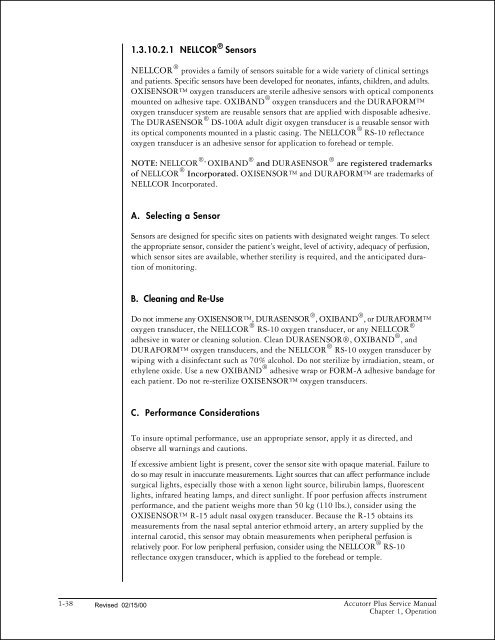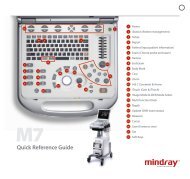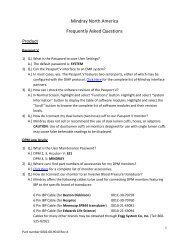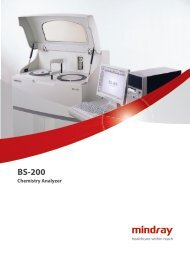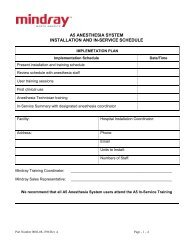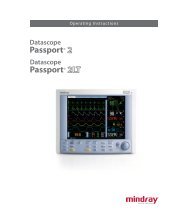Accutorr Plus Service Manual - Mindray
Accutorr Plus Service Manual - Mindray
Accutorr Plus Service Manual - Mindray
You also want an ePaper? Increase the reach of your titles
YUMPU automatically turns print PDFs into web optimized ePapers that Google loves.
1.3.10.2.1 NELLCOR ® Sensors<br />
NELLCOR ® provides a family of sensors suitable for a wide variety of clinical settings<br />
and patients. Specific sensors have been developed for neonates, infants, children, and adults.<br />
OXISENSOR oxygen transducers are sterile adhesive sensors with optical components<br />
mounted on adhesive tape. OXIBAND ® oxygen transducers and the DURAFORM<br />
oxygen transducer system are reusable sensors that are applied with disposable adhesive.<br />
The DURASENSOR ® DS-100A adult digit oxygen transducer is a reusable sensor with<br />
its optical components mounted in a plastic casing. The NELLCOR ® RS-10 reflectance<br />
oxygen transducer is an adhesive sensor for application to forehead or temple.<br />
NOTE: NELLCOR ®, OXIBAND ® and DURASENSOR ® are registered trademarks<br />
of NELLCOR ® Incorporated. OXISENSOR and DURAFORM are trademarks of<br />
NELLCOR Incorporated.<br />
A. Selecting a Sensor<br />
Sensors are designed for specific sites on patients with designated weight ranges. To select<br />
the appropriate sensor, consider the patient’s weight, level of activity, adequacy of perfusion,<br />
which sensor sites are available, whether sterility is required, and the anticipated duration<br />
of monitoring.<br />
B. Cleaning and Re-Use<br />
Do not immerse any OXISENSOR, DURASENSOR ® , OXIBAND ® , or DURAFORM<br />
oxygen transducer, the NELLCOR ® RS-10 oxygen transducer, or any NELLCOR ®<br />
adhesive in water or cleaning solution. Clean DURASENSOR®, OXIBAND ® , and<br />
DURAFORM oxygen transducers, and the NELLCOR ® RS-10 oxygen transducer by<br />
wiping with a disinfectant such as 70% alcohol. Do not sterilize by irradiation, steam, or<br />
ethylene oxide. Use a new OXIBAND ® adhesive wrap or FORM-A adhesive bandage for<br />
each patient. Do not re-sterilize OXISENSOR oxygen transducers.<br />
C. Performance Considerations<br />
To insure optimal performance, use an appropriate sensor, apply it as directed, and<br />
observe all warnings and cautions.<br />
If excessive ambient light is present, cover the sensor site with opaque material. Failure to<br />
do so may result in inaccurate measurements. Light sources that can affect performance include<br />
surgical lights, especially those with a xenon light source, bilirubin lamps, fluorescent<br />
lights, infrared heating lamps, and direct sunlight. If poor perfusion affects instrument<br />
performance, and the patient weighs more than 50 kg (110 lbs.), consider using the<br />
OXISENSOR R-15 adult nasal oxygen transducer. Because the R-15 obtains its<br />
measurements from the nasal septal anterior ethmoid artery, an artery supplied by the<br />
internal carotid, this sensor may obtain measurements when peripheral perfusion is<br />
relatively poor. For low peripheral perfusion, consider using the NELLCOR ® RS-10<br />
reflectance oxygen transducer, which is applied to the forehead or temple.<br />
1-38 Revised 02/15/00<br />
<strong>Accutorr</strong> <strong>Plus</strong> <strong>Service</strong> <strong>Manual</strong><br />
Chapter 1, Operation


